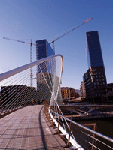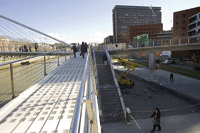
In the Courts: Bridging Moral Rights and Public Utility
By Dr. Juan José Marín López
A recent decision by a court in Bilbao, Spain, has broken new ground in weighing the moral rights of an architect in his work, as protected under Spain’s copyright law, against the public interest. This account of the case was written for WIPO Magazine by Juan José Marín, Professor of Civil Law at the University of Castilla La Mancha and an expert in Spanish copyright law.

Calatrava’s bridge was heralded as a symbol of the new Bilbao. Photo: Josean Prado (2006)
Two bridges
Here are the facts. The world renowned Spanish architect, Santiago Calatrava, was commissioned by the Bilbao municipal authorities to design and oversee the construction of a bridge over the river Nervión, which runs through the middle of the city. The bridge was part of Bilbao’s urban development project to unite the two sides of the river. Construction was completed in May 1997, and the work was received by the city Council to their apparent satisfaction. The bridge, known by its Basque name Zubi Zuri (white bridge) became one of the city’s landmark attractions.
Some years later, two companies began work on the construction and promotion of new riverside complex close to the Zubi Zuri. This too was part of the Bilbao urban regeneration plan. The complex of buildings, for mixed residential, office and leisure use, consisted of two 83 meter high glass towers, which were designed to resemble an open gateway, plus five more buildings arranged in a form described as a “folding screen.” The complex was designed by the prestigious Japanese architect Arata Isozaki, after whom it was named Isozaki Atea (Isozaki’s Gate). In order to connect the new development to the other side of the river via the Zubi Zuri, Arata Isozaki built an extended walkway supported by two concrete pillars. This was attached to Santiago Calatrava’s bridge in 2006 by removing a section of the balustrade.

Arata Isozaki’s extension to the bridge was based on a different design and supported by conventional concrete pillars. Photo: Gabriel Prat
Unhappy with this situation, Mr. Calatrava took legal action against the Bilbao city council and the two companies responsible for constructing the footbridge extension. He claimed infringement of his moral right to the integrity of his work, citing the fact that the extension had been added without his authorization, and nor had his permission been sought for the removal of part of the balustrade. He demanded that the bridge be restored to its original state and Isozaki's walkway demolished, plus 250,000 euros for moral damages and publication of the judgment in the national and specialist press. Alternatively, if the bridge could not be restored, he requested a compensation payment of €3 million.
The arguments
The case, which came before the Bilbao Court in November 2007, attracted widespread interest. Among the most hotly disputed points was the central question of whether Spanish copyright law includes the protection of architectural works. Spain’s 1987 Intellectual Property Law (article 10.1) refers to the protection of the “plans, drawings, scale models and designs of architectural and engineering works.” The way that this is expressed legally could be interpreted to mean that the protection applies only to the plans, drawings, models and designs relating to the work, but not to the final work itself resulting from the construction which was planned or designed by the architect.
Judge Edmundo Rodríguez Achútegui did not accept this restrictive interpretation. He recalled that the list of protected works in the Spanish law was not an exhaustive numerus clausus (closed number), and that the key criterion for protection was that the architectural work must be original. He also recalled the existence of legal precedents for the protection of an architectural work in itself, citing for example the March 2006 decision of the Provincial Court of Barcelona, which recognized copyright protection in the case of the Expiatory Temple of Barcelona’s Sagrada Familia (Holy Family) cathedral. Finally, he noted that the Berne Convention (article 2.1) establishes explicitly that the term “literary and artistic works” also includes works of architecture.
The judge ruled furthermore that an original architectural work is covered by copyright law independently of its function, thus regardless of whether the purpose of the work is to “provide living or working quarters, to promote spirituality, to offer a cultural space or to serve communications.”
The other disputed issue was whether the conduct of the city council and the construction companies violated the moral rights of the architect. In this regard, article 14.4 of Spain’s Intellectual Property Law, analogous to article 6bis of the Berne Convention, enshrines the unalienable right of the author to “demand respect for the integrity of the work and prevent any deformation, modification, alteration or attack on the same which implies harm to his/her legitimate rights or detriment to his/her reputation.” The judge agreed that Santiago Calatrava’s bridge had suffered an alteration: a section of balustrade had been removed, and a walkway had been attached which was built in a completely different style, using a support structure which broke with the design of the plaintiff’s bridge. The grayish color also contrasted markedly with the white bridge. He concluded that the addition to the Zubi Zuri had without question altered its character.
The Spanish Law makes a clear distinction between the rights of the owner of the material work (Bilbao City) and the rights of its author (Mr. Calatrava). The fact that the city council is the legal owner of the architectural work does not entitle it to make alterations to the work which damage its author’s moral rights. Nor does the fact of the evident practical utility of the work – i.e. enabling the citizens of Bilbao to cross the river – prevent the application and validity of the author’s moral rights.
Prioritizing the public interest
“In addition to constituting a singular artistic creation suitable for protection, the work is public one, offering a service to the citizens, and thus satisfies a public interest. If we weigh these interests, the public must prevail over the private.”
In the final analysis, however, the judge determined that the legitimate (private) interests of Mr. Calatrava with respect to the integrity of his work must be weighed, not only in terms of his case against the city council, but also with respect to the (public) interest of the citizens. For the people of Bilbao, the addition of the walkway to the Zubi Zuri enabled them to access the new Isozaki Atea complex on one level, without the difficulty and inconvenience of walking up and down several flights of stairs.
In the conflict between these private and public interests, it was the moral rights of the architect which lost. Judge Achútegui rejected Mr. Calatrava’s demand and ruled that, while alteration of the work had certainly taken place, “the right to the integrity of the work was not breached because the author is obliged to tolerate this in consideration of the public service that his work provides.”
The judge criticized the actions of the city council, stating that it had been wrong not to have put Mr. Calatrava himself in charge of the extension to his bridge. But no penalty was imposed.
The case has not yet run its course. While a spokesperson for Santiago Calatrava described the judgment as providing “moral satisfaction,” his lawyers have now filed an appeal before the Bilbao Provincial Court. Architects, engineers, planning authorities and copyright lawyers in Spain are waiting with keen interest to see whether the decision in this test case on limitations to moral rights will be upheld.
The WIPO Magazine is intended to help broaden public understanding of intellectual property and of WIPO’s work, and is not an official document of WIPO. The designations employed and the presentation of material throughout this publication do not imply the expression of any opinion whatsoever on the part of WIPO concerning the legal status of any country, territory or area or of its authorities, or concerning the delimitation of its frontiers or boundaries. This publication is not intended to reflect the views of the Member States or the WIPO Secretariat. The mention of specific companies or products of manufacturers does not imply that they are endorsed or recommended by WIPO in preference to others of a similar nature that are not mentioned.